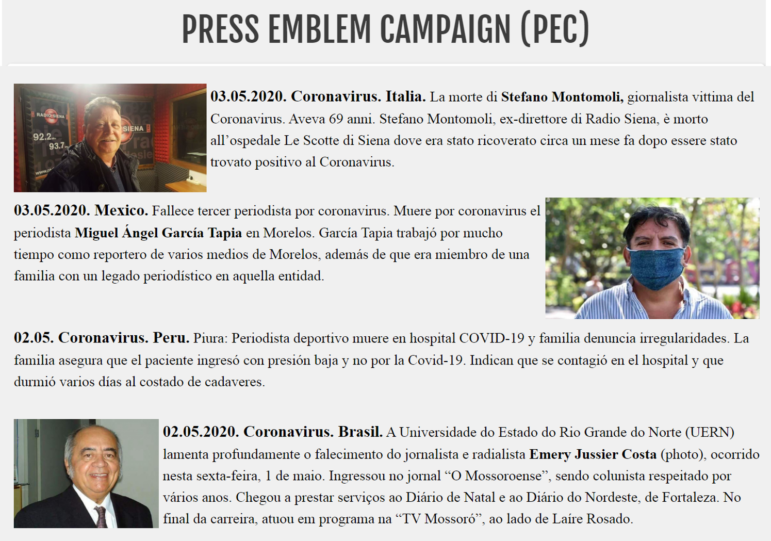

COVID-19’s Toll on Journalists: At Least 64 Dead in 24 Countries
Like health professionals, care givers, and other essential workers, journalists face heightened and grave health risks as they pursue crucial stories on the COVID-19 crisis. But answering a basic question — how many journalists have died from the pandemic — is not easy. Measuring coronavirus-related deaths among media workers presents many of the same problems as counting true mortality figures in the general population.
The Geneva-based Press Emblem Campaign (PEC), a nonprofit focused on press freedom and journalist safety, is attempting to track confirmed COVID-19-related deaths among journalists globally, and they recorded 64 deaths in 24 countries by May 5.

Having begun their count on March 1, PEC is aggregating cases based on online searches in multiple languages, and reports by journalism unions and media companies.
However, the PEC report emphasizes that the number represents a minimum confirmed tally, and that many more reporters are likely to have succumbed to the pandemic.
This is borne out by individual country data now emerging. For instance, on May 3, the PEC had recorded 9 reporter deaths in Ecuador, the worst-hit country for journalist fatalities. But Fundamedios, a press freedom NGO in Latin America, has recorded 12 pandemic-related journalists deaths in the hard-hit Ecuadorian city of Guayaquil alone.

In an email interview, Blaise Lempen, Secretary-General at PEC, said there were several reasons why the global tally represented an undercount, but that it was important to track confirmed cases.
“Of course, (our) sources are insufficient,” Lempen said. “Certainly the real number is higher: first, because some journalists died without being tested; second, others died from coronavirus-related causes such as heart attacks, but whose link cannot be certified; third, because only the deaths of known journalists have been announced; and fourth, in some countries deaths are simply hidden.”
He added: “There was a disaster in the city of Guayaquil: no protection measures.”

Their ongoing track has recorded eight reporter deaths in the US, four in Brazil, and three each in the UK and Spain.
Lempen said PEC’s researchers only recorded deaths officially linked to COVID-19, certified by tests.
“They succumbed to the disease in each case. When there was a doubt, we didn’t count it,” he said.
Some, he said, were tracked from social media posts and family notices.

Lempen said PEC had found it impossible to differentiate between lethal infections caused by reporting activities and those acquired through personal exposure. But it appears obvious, he added, that many were were infected on duty, especially at the start of the epidemic: “Please note that there is a relatively high proportion of young journalists — in their forties, fifties, sixties — not (a lot of) very old.
One prominent fatality is Italian photojournalist Paolo Micai, who died at age 60 on March 23 – weeks after bravely covering the outbreak inside hard-hit hospitals.

The Poynter Institute is another organization documenting and commemorating journalists lost to the pandemic. Reporter Kristen Hare commemorated 16 journalists lost in a recent, updated column – some of them not yet included in the PEC list.
“We are trying to keep a running track here, and we’ve had help from the International News Safety Institute,” says Hare. “I’m also on the lookout for obits of journalists.”
Hare said she planned to dedicate a space in Poynter’s commemorative walkway to journalists who lost their lives to the pandemic.
“It’s an important story to tell,” she said.










